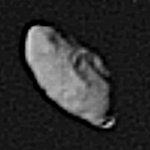
Saturn's innermost three moons are:
 |
orbit: 133,583 km from Saturn
diameter: 20 km
mass: ?
Pan was the god of woods, fields, and flocks, having a human torso
and head with a goat's legs, horns, and ears.
Discovered by Mark R. Showalter in 1990 from Voyager photos.
Pan is within the Encke Gap in Saturn's A ring.
Small moons near the rings produce wave patterns in the rings. Prior to the discovery of Pan, an analysis of the patterns in the edge of Saturn's A ring predicted the size and location of a small moon. Pan was discovered by reexamining the 10 year old Voyager photos at the predicted spot.
It is possible that there are more moons within Saturn's rings yet to be discovered.
 |
orbit: 137,670 km from Saturn
diameter: 30 km (40 x 20)
mass: ?
Atlas was a Titan condemned by Zeus to support the
heavens upon his shoulders; son of Iapetus and the nymph Clymene;
brother of Prometheus and Epimetheus.
Discovered by R. Terrile in 1980 from Voyager photos.
Atlas seems to be a shepherd satellite of the A ring.
 |
orbit: 139,350 km from Saturn
diameter: 91 km (145 x 85 x 62)
mass: 2.7e17 kg
Prometheus was a Titan who stole fire from Olympus and gave
it to humankind, for which Zeus punished him horribly;
son of Iapetus; brother of Atlas and Epimetheus.
"Prometheus" is Greek for "foresight".
Discovered by S. Collins and others in 1980 from Voyager photos.
 Prometheus is the inner shepherd
satellite of the F ring.
Prometheus is the inner shepherd
satellite of the F ring.
Prometheus has a number of ridges and valleys and several craters about 20 km in diameter but appears to be less cratered than the neighboring moons Pandora, Janus and Epimetheus.
From their very low densities and relatively high albedos, it seems likely that Prometheus, Pandora, Janus and Epimetheus are very porous icy bodies. (Note, however, that there is a lot of uncertainty in these values.)